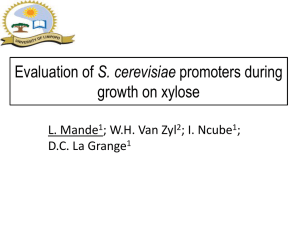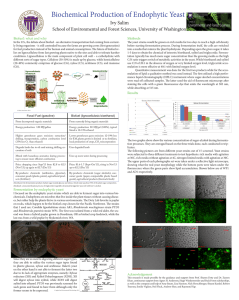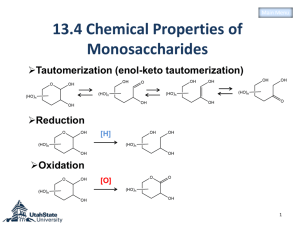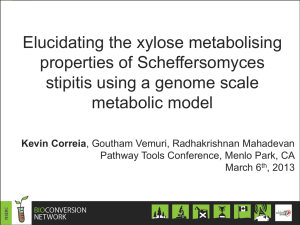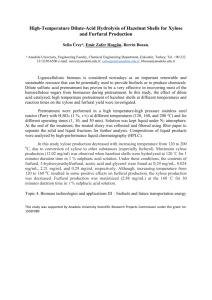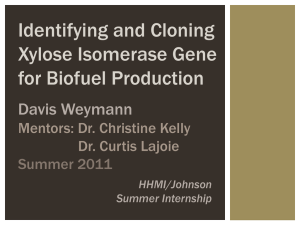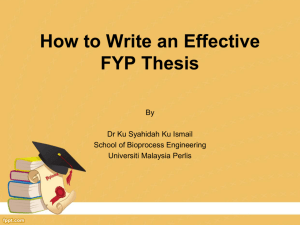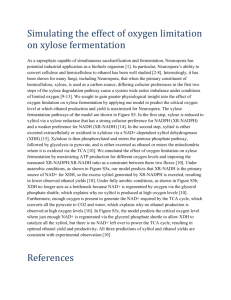The level of glucose-6-phosphate dehydrogenase activity strongly influences xylose fermentation and Saccharomyces
advertisement
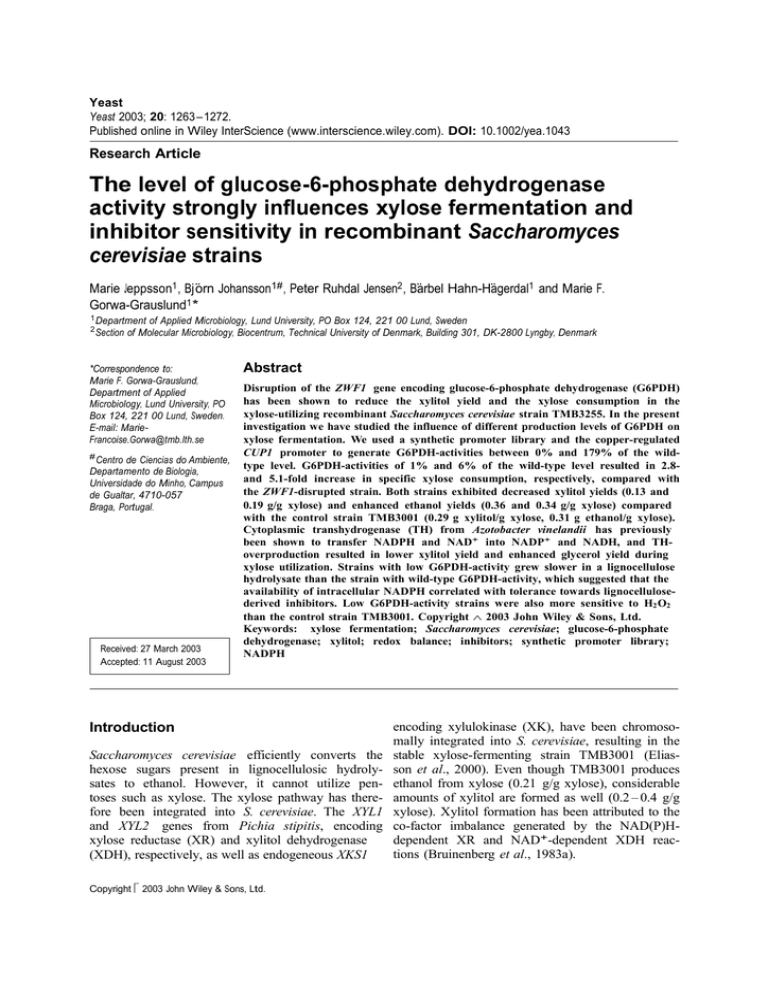
Yeast Yeast 2003; 20: 1263 – 1272. Published online in Wiley InterScience (www.interscience.wiley.com). DOI: 10.1002/yea.1043 Research Article The level of glucose-6-phosphate dehydrogenase activity strongly influences xylose fermentation and inhibitor sensitivity in recombinant Saccharomyces cerevisiae strains Marie Jeppsson1 , Bj örn Johansson1# , Peter Ruhdal Jensen2 , Bärbel Hahn-Hägerdal1 and Marie F. Gorwa-Grauslund1 * 1 Department 2 Section of Applied Microbiology, Lund University, PO Box 124, 221 00 Lund, Sweden of Molecular Microbiology, Biocentrum, Technical University of Denmark, Building 301, DK-2800 Lyngby, Denmark *Correspondence to: Marie F. Gorwa-Grauslund, Department of Applied Microbiology, Lund University, PO Box 124, 221 00 Lund, Sweden. E-mail: MarieFrancoise.Gorwa@tmb.lth.se # Centro de Ciencias do Ambiente, Departamento de Biologia, Universidade do Minho, Campus de Gualtar, 4710-057 Braga, Portugal. Received: 27 March 2003 Accepted: 11 August 2003 Abstract Disruption of the ZWF1 gene encoding glucose-6-phosphate dehydrogenase (G6PDH) has been shown to reduce the xylitol yield and the xylose consumption in the xylose-utilizing recombinant Saccharomyces cerevisiae strain TMB3255. In the present investigation we have studied the influence of different production levels of G6PDH on xylose fermentation. We used a synthetic promoter library and the copper-regulated CUP1 promoter to generate G6PDH-activities between 0% and 179% of the wildtype level. G6PDH-activities of 1% and 6% of the wild-type level resulted in 2.8and 5.1-fold increase in specific xylose consumption, respectively, compared with the ZWF1-disrupted strain. Both strains exhibited decreased xylitol yields (0.13 and 0.19 g/g xylose) and enhanced ethanol yields (0.36 and 0.34 g/g xylose) compared with the control strain TMB3001 (0.29 g xylitol/g xylose, 0.31 g ethanol/g xylose). Cytoplasmic transhydrogenase (TH) from Azotobacter vinelandii has previously been shown to transfer NADPH and NAD+ into NADP+ and NADH, and THoverproduction resulted in lower xylitol yield and enhanced glycerol yield during xylose utilization. Strains with low G6PDH-activity grew slower in a lignocellulose hydrolysate than the strain with wild-type G6PDH-activity, which suggested that the availability of intracellular NADPH correlated with tolerance towards lignocellulosederived inhibitors. Low G6PDH-activity strains were also more sensitive to H2 O2 than the control strain TMB3001. Copyright 2003 John Wiley & Sons, Ltd. Keywords: xylose fermentation; Saccharomyces cerevisiae; glucose-6-phosphate dehydrogenase; xylitol; redox balance; inhibitors; synthetic promoter library; NADPH Introduction Saccharomyces cerevisiae efficiently converts the hexose sugars present in lignocellulosic hydrolysates to ethanol. However, it cannot utilize pentoses such as xylose. The xylose pathway has therefore been integrated into S. cerevisiae. The XYL1 and XYL2 genes from Pichia stipitis, encoding xylose reductase (XR) and xylitol dehydrogenase (XDH), respectively, as well as endogeneous XKS1 Copyright 2003 John Wiley & Sons, Ltd. encoding xylulokinase (XK), have been chromosomally integrated into S. cerevisiae, resulting in the stable xylose-fermenting strain TMB3001 (Eliasson et al., 2000). Even though TMB3001 produces ethanol from xylose (0.21 g/g xylose), considerable amounts of xylitol are formed as well (0.2 – 0.4 g/g xylose). Xylitol formation has been attributed to the co-factor imbalance generated by the NAD(P)Hdependent XR and NAD+-dependent XDH reactions (Bruinenberg et al., 1983a). 1264 M. Jeppsson et al. The oxidative pentose phosphate pathway (PPP) is a major source of NADPH in yeast, but NADPH is also produced via the NADP+-linked isoci- trate dehydrogenase reaction (Bruinenberg et al., 1983b). The ZWF1 gene encoding glucose-6phosphate dehydrogenase has been disrupted in strain TMB3255 to decrease the NADPH level (Jeppsson et al., 2002). TMB3255 showed an enhanced ethanol yield (0.41 g/g xylose) and a decreased xylitol yield (0.05 g/g xylose), however, at the expense of a six-fold lower xylose consump- tion rate. The xylose consumption rate in TMB3255 has been enhanced by increasing the production of xylose reductase (Jeppsson et al., 2003). Another strategy to maintain a high ethanol yield without losing the xylose flux would be to allow a low flux through the oxidative PPP. In the present investigation we constructed and this may result in reduced growth rate. In this investigation, growth rates were determined in a lignocellulose hydrolysate. Strains disrupted in the oxidative pentose phosphate pathway have also shown enhanced sensitivity to oxidative stress (Nogae and Johnston, 1990). The tolerance towards hydrogen peroxide was therefore also evaluated for strains with a range of different G6PDH activities. Materials and methods Strains Strains of S. cerevisiae used in this investigation are summarized in Table 1. Escherichia coli DH5α (Life Technologies, Rockville, MD) was used for sub-cloning. All strains were stored in 20% glyc◦ C. Yeast cells from freshly streaked strains with a range of production levels of G6PDH to erol at −80 generate a range of intracellular NADPH levels. The YPD plates (Ausubel et al., 1995) were used for copper promoter, CUP1 (Labbe and Thiele, inoculation. 1999) was used to facilitate the regulation of the ZWF1 gene expression by changing the Cu2+ con- Nucleic acid manipulation centration of the medium. Additionally, a synthetic promoter library was constructed for expression of Plasmid DNA was prepared with BioRad Plasthe ZWF1 gene at a wider span of activities. Fur- mid Miniprep kit (Hercules, CA). Restriction and thermore, a transhydrogenase-producing strain was modification enzymes were obtained from Roche included to investigate the effects of the reaction (Roche Diagnostics AB, Bromma, Sweden), Ferconverting NADPH and NAD+ into NADP+ and mentas (Vilnius, Lithuania) and Life Technologies NADH (Nissen et al., 2001) on xylose fermen- (Rockville, MD). DNA extractions from agarose tation. Ethanol and xylitol yields, as well as the gel were made by QIAGEN Gel Extraction Kit (QIAGEN GmbH, Hilden, Germany). xylose consumption rate were monitored. Strains with low G6PDH-activity are likely to have reduced levels of NADPH. This may influ- Transformation ence their tolerance towards inhibitors present in lignocellulose hydrolysates. For example, 5- Competent cells of E. coli DH5α were prepared hydroxymethyl furfural (5-HMF) requires NADPH and transformed as described elsewhere (Inoue et al., 1990) and yeast transformations were made for reduction (Wahlbom and Hahn-Hägerdal, 2002) using a lithium acetate method (Gietz et al., 1992), Table 1. Strains used in this study Strain TMB3001 TMB3255 TMB3256 TMB3037 TMB3035 TMB3034 TMB3030 TMB3253 TMB3254 Genotype Reference CEN.PK 113-7A (MATa his3- 1 MAL2-8c SUC2) his3::YIp XR/XDH/XK TMB3001 zwf1::KanMX TMB3001 promoterless ZWF1 TMB3001 YRP13 ZWF1 TMB3001 YRP25 ZWF1 TMB3001 YRP34 ZWF1 TMB3001 CUP1 ZWF1 TMB3001 YEplac112 KanR TMB3001 YEplac112 PGK CTH KanR (Eliasson et al., 2000) (Jeppsson et al., 2002) This work This work This work This work This work This work This work Copyright 2003 John Wiley & Sons, Ltd. Yeast 2003; 20: 1263 – 1272. Effect of G6PDH on xylose fermentation which was slightly modified (G üldener et al., 1996). E. coli transformants were selected on Luria – Bertani (LB) medium plates (Ausubel et al., 1995) with 100 g/ml ampicillin (IBI Shelton Scientific Inc., Shelton, CT). S. cerevisiae transformants were selected on Yeast Nitrogen Base without amino acids (Difco, Sparks, MD) or on YPD plates with 100 g/ml zeocin (Invitrogen, Groningen, The Netherlands) or 150 g/ml geneticin (Life Technologies, Rockville, MD). 1265 TTTTTA TGAAAAATAGCTAGAAGGAATAAGGAATTACAAGAGAGATGTTACAAGAAAGAAG3 (113-mer). The underlined sequences are complementary, facilitating annealing of the downstream part of oligonucleotides 1 and 2. Synthesis of synthetic promoters To create double-stranded DNA, 0.6 nmol oligonucleotide 1 and 1.04 nmol oligonucleotide 2 were mixed with 100 nmol of each dNTP and incubated ◦C with 23.6 units Klenow DNA polyConstruction of the pB3 ZWF1 and pB3 CUP1 for 2 h at 37 ZWF1 vectors merase (Pharmacia Biotech, Uppsala, Sweden) in a Approximately 75% of the 5 end of ZWF1 was total volume of 200 l. The double-stranded DNA cloned by PCR from S. cerevisiae CBS 8066 chro- was purified by agarose gel electrophoresis and mosomal DNA using the primers 5ZWF1 clon 5 - cleaved with EcoRI and Bam HI. GAGGATCCAGAATGAGTGAAGGCCCCGTCAAATTC-3 and 3ZWF1 clon 5 -GAGGATCCCTGCACTCTGATGACCAGTTCG-3 , adding Bam - Construction of the pYLZ-2 YRP vectors HI sites at both ends (bold face). Only the 5 The pYLZ-2 vector (Hermann et al., 1992) conpart was cloned to allow simultaneous integration taining the E. coli lacZ gene was cut with EcoRI and disruption of the wild-type copy of the ZWF1 and Bam HI and the synthetic double-stranded progene. The flanking Bam HI sites were cleaved at moters were ligated to the vector, resulting in the 1150 bp PCR product. The partial ZWF1 ORF the pYLZ-2 YRP vectors. Positive clones were was ligated to the pB3 PGK, cut with Bgl II, result- identified by PCR using the primers 5YRPclon ing in pB3 PGK ZWF1. The PGK1 promoter was and 3YRPclon, as described below, and E. coli removed by restriction cleavage with SacI and colonies as template. Plasmid DNA was prepared Xba I, resulting in the linear fragment pB3 ZWF1 . from 37 positive clones, designated pYLZ-2 YRP The cohesive ends of the remaining promoterless 1 – 37, and used for transformation of S. cerevisiae plasmid were blunted by Klenow DNA polymerase. CEN.PK 113-5D (Entian and K ötter, 1998). TransThe resulting vector was closed by ligation with T4 formants were selected by uracil prototrophy. DNA ligase, generating pB3 ZWF1 vector. The CUP1 promoter was released from the Construction of the pB3 YRP ZWF1 vectors plasmid pCu413 CUP1 (Labbe and Thiele 1999) by restriction cleavage with SacI and SpeI. The CUP1 Three clones of the synthetic promoter library promoter was ligated to pB3 ZWF1 , resulting in (YRP13, YRP25 and YRP34) were used for PCR-amplification with the primers 5YRPclon 5 pB3 CUP1 ZWF1. GATCGAGCTCTGGCCGATTCATTAATCCAGCTGAA-3 and 3YRPclon 5 -GATCTCTAGATTOligonucleotides for synthetic promoter design TGATTTAGTGTTTGTGTGTTGAT-3 . The synTwo synthetic oligonucleotides (DNA Technology thetic promoters were inserted into the promoterA/S, Aarhus, Denmark) were used to generate synless pB3 ZWF1 vector after cleavage with SacI thetic promoters: oligonucleotide 1: 5 ATCAGAAand Xba I (bold face), generating pB3 YRP13 TTCTCGAGNNNNNCTTCCNNNNNACCCATZWF1, pB3 YRP25 ZWF1 and pB3 YRP34 ZWF1. ACANNNNNNNNACCCATACANNNNNCTTConstruction of TMB3256, TMB3030, TMB3037, CCNNNNNNNNNNNNNNNNNNNNNNNNNTMB3035 and TMB3034 NNNNNTATAAANNNNNNNNNNNNNNNNNNNNNNNNNNNNNNNNNNNNNNNCTTCThe vectors pB3 ZWF1, pB3 CUP1 ZWF1, pB3 TTTCTTGTAACATC3 (159-mer) and oligonuclYRP13 ZWF1, pB3 YRP25 ZWF1 and pB3 eotide 2: 5 ATCGGGATCCATTTTGATTTAGTYRP34 ZWF1 were cleaved with Bgl II within GTTTGTGTGTTGATAAGCAGTTGCTTGGTthe ZWF1 gene. The cleavage products were Copyright 2003 John Wiley & Sons, Ltd. Yeast 2003; 20: 1263 – 1272. 1266 used for transformation of TMB3001, generating TMB3256, TMB3030, TMB3037, TMB3035 and TMB3034 after selection for zeocin resistance. Integration was confirmed by PCR amplification with the pB3 PGK-specific primer 5 GAAGTTATTAGGTGATATCAGATCC-3 and the ZWF1-specific primer 3ZWF1 clon. Construction of TMB3253 and TMB3254 The cth gene encoding the Azotobacter vinelandii cytoplasmic transhydrogenase was removed from YEp24-pPGK-CTH (Nissen et al., 2001) using Hin dIII and inserted into YEplac112 (Gietz and Sugino, 1988) using the same site, resulting in YEplac112 PGK CTH. The KanMX gene was removed from pFA6 – KanMX4 (Wach et al., 1994) using Bam HI and SacI, and thereafter inserted in YEplac112 and YEplac112 PGK CTH using the same sites, resulting in YEplac112 KanR and YEplac112 PGK CTH KanR. TMB3001 was transformed with YEplac112 KanR and YEplac112 PGK CTH KanR, resulting in TMB3253 and TMB3254, respectively, after selection for geneticin resistance. Batch fermentation Batch fermentation under oxygen-limited conditions in a defined mineral medium (Verduyn et al., 1992) with xylose as sole carbon source was performed as previously described (Jeppsson et al., 2002). Sampling occurred before xylose was totally consumed. Geneticin (150 g/ml) was added in the batch-fermentation with TMB3253 and TMB3254. Maximal specific growth rates in the presence of 2% lignocellulose hydrolysate (Nilvebrant et al., 2003), 20 g/l glucose, and 0.1 mM methionine were determined using a defined mineral medium (Verduyn et al., 1992) and in-house-built fermentors. Cultivation was conducted anaerobically by sparging with 0.6 l/min N2 gas at 30 ◦ C, 250 rpm stirring, pH 5.5 controlled by autoaddition of 3 M NaOH and a total volume of 750 ml. For TMB3030, 10 M Cu2+ was added to generate a G6PDH-activity above the one of the wild-type. Enzymatic measurements Crude extracts for G6PDH-activity determination were made using the Y-PER reagent (Pierce, Copyright 2003 John Wiley & Sons, Ltd. M. Jeppsson et al. Rockford, IL). Crude extracts for TH-activity determination were made with 0.5 mm glass beads in disintegration buffer (100 mM triethanolamine, 0.5 mM EDTA, 0.5 mM DTT and 1 mM PMSF) through 3 × 5 min of vigorous vortexing. Protein concentration was determined using Coomassie Protein Assay Reagent (Pierce), with bovine serum albumin as standard. The glucose-6-phosphate dehydrogenase activity (G6PDH; EC 1.1.1.49) was measured according to Bergmeyer (1974). β Galactosidase activities were measured in whole cells (Miller, 1972) and the transhydrogenase activity was measured according Voordouw et al. (1979). Enzyme activities for strains used in batch fermentation were measured in precultures, since the cells are in a better physiological condition before than after fermentation with xylose as sole carbon source. Analysis of substrates and products Xylose, xylitol, glycerol, acetate and ethanol concentrations were determined by column liquid chromatography (CLC) as previously described (Jeppsson et al., 2002). Cell dry weight was determined as previously described (Jeppsson et al., 2002). Sensitivity towards H2O2 Minimal inhibitory concentrations (MIC) of H2 O2 were determined in 2 ml YPD medium kept ◦ overnight in test tubes at 30 C and 140 rpm. MIC was defined as the lowest H2 O2 concentration for which no growth was found. Results Effect of modulation of G6PDH activity using the CUP1 promoter The connection between the availability of NADPH and xylitol formation during xylose fermentation was investigated by expressing the ZWF1 gene under control of the Cu2+ -regulated CUP1 pro- moter (Labbe and Thiele, 1999). Integration of pB3 CUP1 ZWF1 into TMB3001 resulted in TMB3030. + gave G6PDH The addition of 0 and 10 M Cu2 activities of 1.040 and 1.567 U/mg protein, respectively. In the control strain TMB3001 the activity was 1.015 U/mg protein, which is about the same Yeast 2003; 20: 1263 – 1272. Effect of G6PDH on xylose fermentation 1267 as the lowest activity feasible with the copper promoter. A batch fermentation of xylose was performed under oxygen-limited conditions with the control strain TMB3001 and with TMB3030 at 10 M Cu2+ . The cells did not grow under these conditions, and the xylose was therefore converted only to xylitol, glycerol, acetate, ethanol and carbon dioxide. The higher G6PDH-activity in TMB3030 resulted in a higher xylitol yield (0.33 g/g) than in TMB3001 (0.29 g/g) (Table 2). The xylose consumption rate was the same for the two strains, indicating that the xylose consumption rate can not be enhanced by increasing the G6PDH activity above the wild-type level. Addition of 10 M Cu2+ to TMB3001 did not affect xylose consumption and product yields (data not shown). Since the CUP1 promoter turned out to be unsuitable for downregulation of ZWF1 expression, a synthetic promoter library was constructed. Construction of a promoter library for downregulation of ZWF1 In order to modulate the ZWF1 expression, a library of synthetic promoters was designed. The promoter (Figure 1), called YRP, contains two regulatory structures, RPG boxes (Nieuwint et al., 1989) and CT boxes (Baker, 1986, 1991). These elements promote transcription of ribosomal protein genes and glycolytic genes (Rotenberg and Woolford, 1986; Baker, 1991). The CT boxes and RPG boxes were designed to be degenerated; at each position, 1% each of the three other bases was incorporated during synthesis (Figure 1). Completely degenerated intervening sequences combined with less degenerated transcription factor binding sites results in a wide range of different promoter strengths (Jensen, 1997; Jensen and Hammer, 1998a, 1998b). In Lactococcus lactis, nucleotides at a number of positions are well conserved between different promoters, and upon these sequences the synthetic promoter can be modelled (Jensen and Hammer, 1998a, 1998b). However, S. cerevisiae does not appear to have a strict sequence for promoters; instead the synthetic promoter was pieced together with a combination of structures from several S. cerevisiae promoters. The distance between the RPG box and the CT box was the same as in the glycolytic PYK1 promoter (Drazinic et al., 1996), since it had been shown to be the best for interaction between the transcription factors GCR1p and RAP1p (Drazinic et al., 1996), which bind to the RPG box and CT box, respectively. The distance between the RPG boxes was chosen to be the same as in the ribosomal protein promoter RP39A (Rotenberg and Woolford, 1986). The constant sequence between the TATA box and the 3 end of the promoters was the same as in the ENO1 promoter (Uemura et al., 1997). The synthetic Table 2. Effect of different expression levels of ZWF1 in recombinant S. cerevisiae in oxygen-limited batch fermentation with 50 g/l xylose as sole carbon source. Specific xylose consumption rate (g/g biomass/h) and ethanol, xylitol, acetate and glycerol yields (g/g consumed xylose) and carbon recoveries (cmoles out/cmoles in) were determined after 60 – 70 h. The presented values are the mean of two independent fermentation experiments plus/minus the deviation from the mean. In calculation of carbon recovery, 0.5 moles CO2 are assumed to be formed for each cmole of ethanol or acetate produced. Maximal specific growth rates, max (h−1 ) were measured under anaerobic conditions with 2% lignocellulose hydrolysate and 20 g/l glucose. For minimal inhibitory concentration, MIC, of H2 O2 (%) steps of 0.75% H2 O2 were investigated and double samples were made. NM, not measured. G6PDH activities were measured in precultures Strains Xylose G6PDH consumption activity rate Y(Ethanol) Y(Xylitol) TMB3255∗ <0.01 TMB3256 0.014 TMB3037 0.056 TMB3001∗ 1.015 TMB3030 1.040 (0 M Cu2+ ) TMB3030 1.567 (10 M Cu2+ ) ∗ 0.05 ± 0.01 0.13 ± 0.02 0.19 ± 0.01 0.29 ± 0.01 NM Y(Acetate) 0.084 ± 0.005 0.054 ± 0.003 0.039 ± 0.001 0.025 ± 0.001 NM Y(Glycerol) max CMIC recovery (h−1 ) (% H2 O2 ) 0.022 ± 0.002 0.062 ± 0.002 0.112 ± 0.003 0.145 ± 0.002 NM 0.41 ± 0.02 0.36 ± 0.02 0.34 ± 0.01 0.31 ± 0.01 NM 0.054 ± 0.008 0.044 ± 0.001 0.037 ± 0.001 0.052 ± 0.004 NM 0.95 0.96 0.99 0.98 NM 0.19 0.21 0.26 0.28 NM 6.75 NM 6.75 9.75 NM 0.150 ± 0.001 0.28 ± 0.01 0.33 ± 0.01 0.025 ± 0.001 0.051 ± 0.003 0.97 0.21 NM Fermentation data from Jeppsson et al. (2002). Copyright 2003 John Wiley & Sons, Ltd. Yeast 2003; 20: 1263 – 1272. 1268 M. Jeppsson et al. EcoRI CT-box RPG-box RPG-box ATCAGAATTCTCGAGNNNNNCTTCCNNNNNACCCATACANNNNNNNNACCCA CT-box TATA-box TACANNNNNCTTCCNNNNNNNNNNNNNNNNNNNNNNNNNNNNNNTATAANN NNNNNNNNNNNNNNNNNNNNNNNNNNNNNNNNNNNNNNCTTCTTTCTTGTA ACATCTCTCTTGTAATTCCTTATTCCTTCTAGCTATTTTTCATAAAAAACCAAG BamHI CAACTGCTTATCAACACACAAACACTAAATCAAAATGGATCCCGAT Figure 1. Base sequence of the synthetic promoter YRP. n = 25% of each base, transcription factor binding sites (RPG box and CT box) have 1% each of the bases other than indicated at each position double-stranded promoters were ligated to the vector pYLZ-2 (Hermann et al., 1992) containing the E. coli lacZ reporter gene, resulting in pYLZ-2 YRP vectors. Thirty-seven different clones of the promoter were used to control the lacZ reporter gene in vectors pYLZ-2 YRP 1 – 37. The resulting β -galactosidase activities ranged from 0.007 to 37 Miller units (Figure 2), covering about three orders of magnitude between the lowest and the highest activity. Three selected promoter clones YRP13 [1 Miller unit (MU)], YRP25 (4 MU), and YRP34 (22 MU) (shaded in Figure 2), were used to control the expression of the ZWF1 gene in TMB3001, resulting in TMB3037, TMB3035 and TMB3034, respectively. When harvested in exponential phase on YPD medium TMB3037, TMB3035 and TMB3034 had G6PDH-activities of 0.11, 0.77 and 1.82 U/mg protein, respectively, which corresponded with the expected order of the strength of the promoters. Xylose fermentation with strains with downregulated ZWF1 The synthetic promoter YRP13 produced the lowest G6PDH activity in TMB3037 (0.056 U/mg protein in defined medium), so this strain was selected for batch fermentation with xylose. TMB3037 consumed 0.112 g xylose g biomass/h, which is five times faster than in TMB3255 (zwf1 ), and represents 77% of the specific consumption observed Copyright 2003 John Wiley & Sons, Ltd. in the control strain TMB3001 (Table 2). As expected, TMB3037 had a higher ethanol yield (0.34 g/g) than TMB3001 (0.31 g/g), accompanied by a lower xylitol yield (0.19 g/g vs. 0.29 g/g). In an attempt to obtain even lower expression levels of ZWF1, a strain with a promoterless ZWF1 gene was constructed by integration of pB3 ZWF1 into TMB3001. The resulting strain, TMB3256, had a G6PDH activity of 0.014 U/mg protein, which is about 1% of the wild-type activity (Table 2). Batch fermentation conducted with 50 g/l xylose showed that TMB3256 had a specific xylose consumption of 0.062 g/g biomass/h, which corresponds to a 2.8fold increase compared with TMB3255 (zwf1 ). At the same time, TMB3256 showed an ethanol yield of 0.36 g/g and a xylitol yield of 0.13 g/g, which are close to the values of TMB3255 (zwf1 ) (Table 2). The connection between G6PDH activity, xylitol yields, ethanol yields and xylose consumption are illustrated in strains with G6PDH activities spanning from 0 U/mg protein to 1.6 U/mg protein (Table 2). The ZWF1-disrupted strain TMB3255 exhibited the highest ethanol yield (0.41 g/g) and lowest xylitol yield (0.05 g/g), whereas the TMB3030 strain at 10 M Cu2+ had the lowest ethanol yield (0.28 g/g) and the highest xylitol yield (0.33 g/g) of the strains in Table 2. The xylose consumption rate was not further enhanced at G6PDH-activity above wild-type level. Yeast 2003; 20: 1263 – 1272. Effect of G6PDH on xylose fermentation 1269 YRP37 YRP36 YRP35 YRP34 YRP33 YRP32 YRP31 YRP30 YRP29 YRP28 YRP27 YRP26 YRP25 YRP24 YRP23 YRP22 YRP21 YRP20 YRP19 YRP18 YRP17 YRP16 YRP15 YRP14 YRP13 YRP12 YRP11 YRP10 YRP9 YRP8 YRP7 YRP6 YRP5 YRP4 YRP3 YRP2 YRP1 pYLZ-2 0.001 0.01 0.1 1 10 100 - Galactosidase activity (Miller units) Figure 2. Specific β -galactosidase activity (Miller units) from YRP1 to YRP37 controlling lacZ in pYLZ-2 in S. cerevisiae. Shaded clones (YRP13, YRP25, YRP34) were used to regulate the expression of ZWF1 Overproduction of transhydrogenase If the fermentation pattern seen in low G6PDHactivity strains is a result of low intracellular levels of NADPH, a similar phenotype should be observed at overproduction of the cytoplasmic transhydrogenase (TH) from Azotobacter vinelandii. In S. cerevisiae, this enzyme has been shown to catalyse the conversion of NADPH and NAD+ to NADP+ and NADH, so that the ratio NADPH : NADP+ shifted from 5.1 to 3.0 at THoverproduction (Nissen et al., 2001). TH was overproduced at 1.0 U/mg in TMB3254 (Table 3). No TH activity was detected in the Copyright 2003 John Wiley & Sons, Ltd. control strain. The xylose consumption was similar in the TH-overexpressing strain compared to its control. TH-overproduction resulted in 12% lower xylitol yield and 29% higher glycerol yield. Ethanol and acetate yields were similar with and without TH overproduction. Maximal specific growth rates in lignocellulose hydrolysate Strains in which the G6PDH activity is reduced are impaired in their ability to produce NADPH. This may influence the strains’ tolerance towards inhibitors present in lignocellulosic hydrolysates, Yeast 2003; 20: 1263 – 1272. 1270 M. Jeppsson et al. Table 3. Effect of transhydrogenase overproduction in recombinant S. cerevisiae in oxygen-limited batch fermentation with 50 g/l xylose as sole carbon source. Specific xylose consumption rate (g/g biomass/h) and ethanol, xylitol, acetate and glycerol yields (g/g consumed xylose) and carbon recoveries (cmoles out/cmoles in) were determined after 40 h. The presented values are the mean of two independent fermentation experiments ± the deviation from the mean. In calculation of carbon recovery, 0.5 moles CO2 are assumed to be formed for each cmole ethanol or acetate produced. Specific TH activities were measured in cells harvested in exponential phase after growth on YPD medium Strains TH activity Xylose consumption rate TMB3253 TMB3254 <0.01 1.0 0.157 ± 0.004 0.162 ± 0.002 Y(Ethanol) Y(Xylitol) Y(Acetate) Y(Glycerol) C-recovery 0.28 ± 0.007 0.28 ± 0.003 0.34 ± 0.001 0.30 ± 0.002 0.036 ± 0.001 0.036 ± 0.001 0.059 ± 0.002 0.076 ± 0.001 0.98 0.97 since for example, 5-HMF is reduced with NADPH (Wahlbom and Hahn-Hägerdal, 2002). In previous work, we showed that the disrupted strain TMB3255 (zwf1 ) and TMB3001 had similar anaerobic maximal specific growth rates on glucose in defined mineral medium (Verduyn et al., 1992) supplemented with 0.1 mM methionine (Jeppsson et al., 2003). TMB3255 (zwf1 ) grows 54% slower than TMB3001 when methionine is left out (Jeppsson et al., 2003). Under aerobic conditions, the growth rate of TMB3255 was not fully restored by methionine-addition (Jeppsson et al., 2003). Anaerobic growth rates were measured for TMB3030, TMB3001, TMB3037, TMB3256 and TMB3255 in 2% lignocellulosic hydrolysate and 20 g/l glucose, supplemented with 0.1 mM methionine. Since we supplemented the medium with methionine, and the cultures were run anaerobically, differences in growth rate between strains result solely from the presence of hydrolysate. For TMB3030, 10 M Cu2+ was also added. Maximal specific growth rates decreased with decreasing G6PDH-activity (Table 2). TMB3001, TMB3037, TMB3256 and TMB3255 had maximal specific growth rates of 0.28, 0.26, 0.21 and 0.19/h, respectively. TMB3030 had the highest G6PDH activity but it only grew at 0.21/h, which is probably due to inhibition by Cu2+ . Minimal inhibitory concentrations (MIC) of H2O2 Strains disrupted in the oxidative pentose phosphate pathway display enhanced sensitivity to oxidative stress (Nogae and Johnston, 1990), which has been ascribed to reduced levels of NADPH. This was also observed in our hands, where TMB3001 had a MIC of 9.75 vol% H2 O2, whereas Copyright 2003 John Wiley & Sons, Ltd. TMB3037 and TMB3255 both had a MIC of 6.75 vol% H2O2 (Table 2). Discussion In a previous investigation (Jeppsson et al., 2002), we demonstrated the connection between a low flux through the oxidative PPP and a low xylitol yield. However, the specific xylose consumption in the ZWF1-disrupted strain (TMB3255) was sixfold lower than for the control strain TMB3001. In the present investigation we looked into the effect of different expression levels of ZWF1 on xylose fermentation. We showed that xylose consumption in a G6PDH-deficient strain could be enhanced by allowing a low G6PDH activity, although at the expense of a higher xylitol yield. TMB3256 and TMB3037 had 1% and 6% of the wildtype level of G6PDH activity, respectively. The xylose consumption rate was 2.8 times higher for TMB3256 and 5.1 times higher for TMB3037 than in the ZWF1-disrupted strain TMB3255 (zwf1 ). The xylitol yields increased 2.6 times for TMB3256 and 3.8 times for TMB3037. Thus, there is a trade-off between high xylose consumption rate and low xylitol yield when ZWF1 expression level is modulated. The synthetic promoter library was useful for downregulation of ZWF1. The β -galactosidase activities covered a range of about three orders of magnitude between the lowest and the highest activity, and since the maximal strength appears to be in the same range as the CUP1 promoter, this library should be useful for both up- and downregulation of many genes in S. cerevisiae. Synthetic promoter libraries have earlier been described for Lactococcus lactis (Jensen and Hammer, 1998a), E. Yeast 2003; 20: 1263 – 1272. Effect of G6PDH on xylose fermentation coli (Jensen and Hammer, 1998b) and mammalian cells (Tornoe et al., 2002). The synthetic promoters did not require an inducing agent, in contrast to, for example, the CUP1 promoter which requires supplementation of Cu2+ . The cytoplasmic transhydrogenase from A. vinelandii has been shown to transfer NAD+ and NADPH into NADH and NADP+ (Nissen et al., 2001). The overproduction of transhydrogenase in S. cerevisiae resulted in a lower xylitol yield. Since this was also observed in strains with decreased G6PDH activity, it further strengthens the hypothesis that the decreased xylitol yield is a result of lower NADPH level. We observed enhanced glycerol yield from xylose at TH overproduction. This has also been observed on glucose (Nissen et al., 2001) and was then ascribed to the necessary reoxidation of NADH formed in the TH reaction. If the transhydrogenase had been working in the opposite direction we might have been able to remove excess NADP+ and NADH formed in the XR and XDH reactions, respectively. A strategy to overcome the redox imbalance between the XR and XDH reactions has recently been initiated by Verho et al. (2002). The Kluyveromyces lactis gene encoding a NADP+ -dependent glyceraldehyde 3phosphate dehydrogenase has been introduced in xylose-fermenting S. cerevisiae to reduce accumulation of NADP+ and NADH, and thereby enhance the ethanol yield. Another strategy for creating a co-factor balanced breakdown of xylose was to subject xylose reductase to site-specific mutagenesis to shift the co-factor preference towards NADH (Zhang and Lee, 1997; Kostrzynska et al., 1998). However, when the Km of NADPH was enhanced, Km for xylose increased concomitantly. The growth rates in lignocellulose hydrolysate were significantly lower in the strains with 0% and 1% G6PDH activity, whereas no significant decrease was observed for TMB3037 with 6% G6PDH activity compared to the control strain. Lignocellulose-derived inhibitors fall in three groups: low-molecular-weight aliphatic acids (predominantly acetic acid, formic acid and levulinic acid), furan derivatives (furfural and 5-HMF) and phenolic compounds (Larsson et al., 1999). 5HMF requires NADPH for reduction (Wahlbom and Hahn-Hägerdal, 2002). This co-factor is also needed for biomass formation, which may explain Copyright 2003 John Wiley & Sons, Ltd. 1271 the lower growth rates found for the low G6PDH activity strains. Another mechanism of growth inhibition is the interference of aliphatic acids with ATP requirements. Acetic acid has been shown to lower the maximal specific growth rate of S. cerevisiae (Pampulha and Loureiro-Dias, 2000) and at high external acetic acid concentrations the intracellular pH is decreased (Pampulha and Loureiro-Dias, 1989). When the plasma membrane ATPase pumps out protons it uses ATP, which results in less ATP being available for biomass formation. We showed in the present investigation that the acetate yield is enhanced in strains with low G6PDH activity. These strains may therefore encounter difficulties with providing the ATP required for maintaining the intracellular pH. In this investigation we have illustrated the effect of modulated G6PDH activities on xylose fermentation. The best ethanol yield was found in the ZWF1-disrupted strain TMB3255, but this strain also had the lowest xylose consumption rate and a significantly reduced growth rate in lignocellulose hydrolysate. TMB3037 had only 6% of wild-type G6PDH activity but the xylose consumption rate was 77% of the consumption rate found in the control strain. This strain also had almost the same maximal specific growth rate in a lignocellulose hydrolysate as TMB3001. Acknowledgements We thank Professor Morten C. Kielland-Brandt, Carlsberg Laboratories, and Professor Jens Nielsen, DTU, for providing us with the YEp24-pPGK-CTH vector. ˚Asa Ekman and Christer Larsson are gratefully acknowledged for technical assistance. This work was financially supported by The Swedish National Energy Administration and the Nordic Energy Research Programme. M.F.G.-G. was supported by Marie Curie fellowship QLK3-CT-1999-51355 from The European Community. References Ausubel FM, Brent R, Kingston E, et al. 1995. Current Protocols in Molecular Biology; John Wiley & Sons, Inc.: New York. Baker HV. 1986. Glycolytic gene expression in Saccharomyces cerevisiae : nucleotide sequence of GCR1, null mutants, and evidence for expression. Mol Cell Biol 6: 3774 – 3784. Baker HV. 1991. GCR1 of Saccharomyces cerevisiae encodes a DNA binding protein whose binding is abolished by mutations in the CTTCC sequence motif. Proc Natl Acad Sci USA 88: 9443 – 9447. Yeast 2003; 20: 1263 – 1272. 1272 Bergmeyer H. 1974. Methods in Enzymatic Analysis. Academic Press: New York. Bruinenberg P, de Bot P, van Dijken J, Scheffers A. 1983a. The role of redox balances in the anaerobic fermentation of xylose by yeasts. Eur J Appl Microbiol Biotechnol 18: 287 – 292. Bruinenberg PM, van Dijken JP, Scheffers WA. 1983b. A theoretical analysis of NADPH production and consumption in yeasts. J Gen Microbiol 129: 953 – 964. Drazinic CM, Smerage JB, Lopez MC, Baker HV. 1996. Activation mechanism of the multifunctional transcription fac- tor repressor – activator protein 1 (Rap1p). Mol Cell Biol 16: 3187 – 3196. Eliasson A, Christensson C, Wahlbom CF, Hahn-H ägerdal B. 2000. Anaerobic xylose fermentation by recombinant Saccharomyces cerevisiae carrying XYL1, XYL2, and XKS1 in mineral medium chemostat cultures. Appl Environ Microbiol 66: 3381 – 3386. Entian KD, K ötter P. 1998. Yeast mutant and plasmid collections. Yeast Gene Analysis, vol 26, Tuite AJP, Brown MF (eds). Academic Press: London; 431 – 449. Gietz RD, Sugino A. 1988. New yeast – Escherichia coli shuttle vectors constructed with in vitro mutagenized yeast genes lacking six-base pair restriction sites. Gene 74: 527 – 534. Gietz D, St Jean A, Woods RA, Schiestl RH. 1992. Improved method for high efficiency transformation of intact yeast cells. Nucleic Acids Res 20: 1425. G üldener U, Heck S, Fielder T, Beinhauer J, Hegemann JH. 1996. A new efficient gene disruption cassette for repeated use in budding yeast. Nucleic Acids Res 24: 2519 – 2524. Hermann H, Hacker U, Bandlow W, Magdolen V. 1992. pYLZ vectors: Saccharomyces cerevisiae – Escherichia coli shuttle plasmids to analyze yeast promoters. Gene 119: 137 – 141. Inoue H, Nojima H, Okayama H. 1990. High efficiency transformation of Escherichia coli with plasmids. Gene 96: 23 – 28. Jensen PR. 1997. Patent PCT/DK97/00342. Jensen PR, Hammer K. 1998a. Artificial promoters for metabolic optimization. Biotechnol Bioeng 58: 191 – 195. Jensen PR, Hammer K. 1998b. The sequence of spacers between the consensus sequences modulates the strength of prokaryotic promoters. Appl Environ Microbiol 64: 82 – 87. Jeppsson M, Johansson B, Hahn-H ägerdal B, Gorwa-Grauslund M. 2002. Reduced oxidative pentose phosphate pathway flux in recombinant xylose-utilizing Saccharomyces cerevisiae strains improves the ethanol yield from xylose. Appl Environ Microbiol 68: 1604 – 1609. Jeppsson M, Tr äff K, Johansson B, Hahn-Hägerdal B, GorwaGrauslund M. 2003. Effect of enhanced xylose reductase activity on xylose consumption and product distribution in xylosefermenting recombinant Saccharomyces cerevisiae . FEMS Yeast Res 3: 167 – 175. Kostrzynska M, Sopher CR, Lee H. 1998. Mutational analysis of the role of the conserved lysine-270 in the Pichia stipitis xylose reductase. FEMS Microbiol Lett 159: 107 – 112. Labbe S, Thiele DJ. 1999. Copper ion inducible and repressible promoter systems in yeast. Methods Enzymol 306: 145 – 153. Copyright 2003 John Wiley & Sons, Ltd. M. Jeppsson et al. Larsson S, Palmqvist E, Hahn-H ägerdal B, et al. 1999. The generation of fermentation inhibitors during dilute acid hydrolysis of softwood. Enzyme Microb Technol 24: 151 – 159. Miller JH. 1972. Experiments in Molecular Genetics. Cold Spring Harbor Laboratory Press: New York. Nieuwint RT, Mager WH, Maurer KC, Planta RJ. 1989. Mutational analysis of the upstream activation site of yeast ribosomal protein genes. Curr Genet 15: 247 – 251. Nilvebrant N-O, Persson P, Reimann A, et al. 2003. Limits for alkaline detoxification of dilute acid lignocellulose hydrolysates. Appl Biochem Biotechnol 107: 615 – 628. Nissen TL, Anderlund M, Nielsen J, Villadsen J, KiellandBrandt MC. 2001. Expression of a cytoplasmic transhydrogenase in Saccharomyces cerevisiae results in formation of 2oxoglutarate due to depletion of the NADPH pool. Yeast 18: 19 – 32. Nogae I, Johnston M. 1990. Isolation and characterization of the ZWF1 gene of Saccharomyces cerevisiae, encoding glucose-6phosphate dehydrogenase. Gene 96: 161 – 169. Pampulha ME, Loureiro-Dias MC. 1989. Combined effect of acetic acid, pH and ethanol on intracellular pH of fermenting yeast. Appl Microbiol Biotechnol 31: 547 – 550. Pampulha ME, Loureiro-Dias MC. 2000. Energetics of the effect of acetic acid on growth of Saccharomyces cerevisiae . FEMS Microbiol Lett 184: 69 – 72. Rotenberg MO, Woolford JL Jr. 1986. Tripartite upstream promoter element essential for expression of Saccharomyces cerevisiae ribosomal protein genes. Mol Cell Biol 6: 674 – 687. Tornoe J, Kusk P, Johansen TE, Jensen PR. 2002. Generation of a synthetic mammalian promoter library by modification of sequences spacing transcription factor binding sites. Gene 297: 21 – 32. Uemura H, Koshio M, Inoue Y, Lopez MC, Baker HV. 1997. The role of Gcr1p in the transcriptional activation of glycolytic genes in yeast Saccharomyces cerevisiae . Genetics 147: 521 – 532. Wach A, Brachat A, Pohlmann R, Philippsen P. 1994. New heterologous modules for classical or PCR-based gene disruptions in Saccharomyces cerevisiae . Yeast 10: 1793 – 1808. Wahlbom CF, Hahn-H ägerdal B. 2002. Furfural, 5hydroxymethyl furfural, and acetoin act as external electron acceptors during anaerobic fermentation of xylose in recombinant Saccharomyces cerevisiae . Biotechnol Bioeng 78: 172 – 178. Verduyn C, Postma E, Scheffers WA, Van Dijken JP. 1992. Effect of benzoic acid on metabolic fluxes in yeasts: a continuousculture study on the regulation of respiration and alcoholic fermentation. Yeast 8: 501 – 517. Verho R, Richard P, Jonson PH, et al. 2002. Identification of the first fungal NADP – GAPDH from Kluyveromyces lactis . Biochemistry 41: 13 833 – 13 838. Voordouw G, Veeger C, Van Breemen JF, Van Bruggen EF. 1979. Structure of pyridine nucleotide transhydrogenase from Azotobacter vinelandii . Eur J Biochem 98: 447 – 454. Zhang Y, Lee H. 1997. Site-directed mutagenesis of the cysteine residues in the Pichia stipitis xylose reductase. FEMS Microbiol Lett 147: 227 – 232. Yeast 2003; 20: 1263 – 1272.
